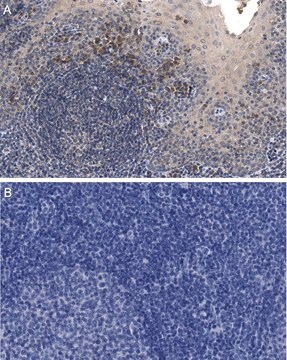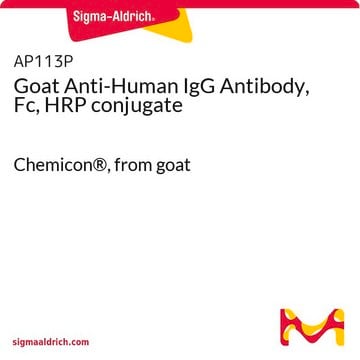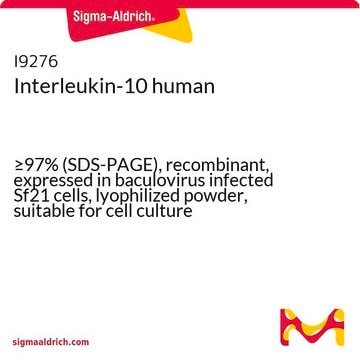MAB1004
Anti-Interleukin-6 Antibody, clone 4B6
clone 4B6, Chemicon®, from mouse
Sinónimos:
IL-6
About This Item
Productos recomendados
biological source
mouse
Quality Level
antibody form
purified immunoglobulin
antibody product type
primary antibodies
clone
4B6, monoclonal
species reactivity
sheep
manufacturer/tradename
Chemicon®
technique(s)
ELISA: suitable
isotype
IgG1
NCBI accession no.
UniProt accession no.
shipped in
dry ice
target post-translational modification
unmodified
Gene Information
sheep ... Il6(443406)
Specificity
SPECIES REACTIVITY:
The antibody is likely to react with caprine (goat) IL-6.
Immunogen
Application
Optimal working dilutions must be determined by the end user.
Suggested ELISA Protocol For Ovine IL-6
1. Coat high capacity microtitre wells (e.g. Nunc maxisorp) with monoclonal anti-IL-6 antibody (Chemicon Catalog Number MAB1004) at a concentration of 5 μg/mL in 0.1 M carbonate buffer pH 9.6 overnight at 4ºC.
2. Wash wells 3 x with PBS + 0.05% Tween 20 (PBST).
3. Add samples to wells. Incubate at room temperature in a humidified box for 1 hour. Wash 3 x with PBST.
4. Dilute rabbit anti-IL-6 (Chemicon Catalog Number AB1839) 1:500 in PBST and add 100 μL to wells. Incubate at room temperature for 30 minutes. Wash 3 x with PBST.
5. Dilute anti-rabbit IgG-HRP to appropriate level in PBST and add 100 μL to wells. Incubate 30 minutes at room temperature. Wash 3 x with PBST.
6. Add 100 μL of TMB chromagen to each well. Incubate for 5-10 minutes and stop reaction with 50 μL of 2M sulfuric acid.
Notes:
The anti-rabbit IgG HRP must be adsorbed against mouse immunoglobulin, and should be checked for non-reactivity with coated plates.
Non-specific binding may be reduced by addition of protein such as skim milk powder to the diluents.
Assay sensitivity may be altered by adjusting incubation times and reagent concentrations.
Inflammation & Immunology
Cytokines & Cytokine Receptors
Physical form
Storage and Stability
Other Notes
Legal Information
Disclaimer
Not finding the right product?
Try our Herramienta de selección de productos.
Storage Class
10 - Combustible liquids
wgk_germany
WGK 2
flash_point_f
Not applicable
flash_point_c
Not applicable
Certificados de análisis (COA)
Busque Certificados de análisis (COA) introduciendo el número de lote del producto. Los números de lote se encuentran en la etiqueta del producto después de las palabras «Lot» o «Batch»
¿Ya tiene este producto?
Encuentre la documentación para los productos que ha comprado recientemente en la Biblioteca de documentos.
Nuestro equipo de científicos tiene experiencia en todas las áreas de investigación: Ciencias de la vida, Ciencia de los materiales, Síntesis química, Cromatografía, Analítica y muchas otras.
Póngase en contacto con el Servicio técnico







